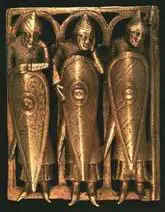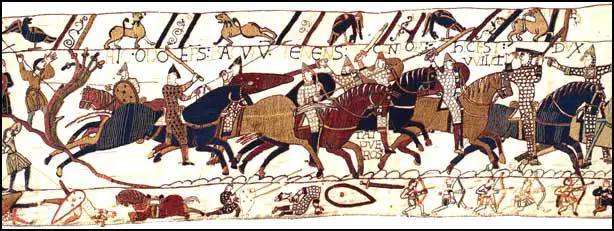Odo of Bayeux

Odo, the son of Herluin of Conteville and Herleva of Falaise, was born in about 1036. Herleva was also the mother of William of Normandy, Richard Fitz Gilbert and Robert of Mortain.
In 1049 William of Normandy appointed Odo bishop of Bayeux and over the next few years organized the rebuilding of Bayeux Cathedral.
When William decided to invade England in 1066, he invited his three half-brothers, Odo, Richard Fitz Gilbert and Robert of Mortain to join him. One Norman chronicler claims that Odo of Bayeux contributed 100 ships to William's invasion fleet.
He fought at the Battle of Hastings and afterwards was given the title of Earl of Kent and the castle at Dover. After his coronation in 1066, William the Conqueror claimed that all the land in England now belonged to him. William retained about a fifth of this land for his own use. The rest was distributed to those men who had helped him defeat Harold. Odo was granted manors in thirteen counties which gave him an income of over £3,000 per year, making him the richest tenant-in-chief in the kingdom.
In 1067 William the Conqueror appointed Odo as regent while he spent time in Normandy. For the next fifteen years Odo he was second in power to William in England. It is believed that Odo commissioned the Bayeux Tapestry.
William was in Normandy in 1073 and Odo of Bayeux had the task of dealing with the rebellion led by Waltheof and Ralph, Earl of Norfolk. On his return in 1076, Waltheof was executed - the only time capital punishment was inflicted on an English leader during his reign. However, the Earl of Norfolk managed to escape to Brittany.
In 1082 William heard complaints about Odo's rule. He returned to England and Odo was arrested and charged with misgovernment and oppression. Found guilty he was kept in prison until Robert of Mortain achieved his release on the death of William the Conqueror in 1087.
Robert Curthose, William's eldest son, was expected to become king of England when his father died. However, William preferred William Rufus, who, unlike Robert, had remained loyal to his father. William Rufus became king of England in 1087 and the following year, Odo, Geoffrey of Coutances, Robert of Mortain and Richard Fitz Gilbert led a rebellion against his rule. Many Normans remained loyal and William defeated the rebels when he captured Tonbridge Castle.
Odo was forced to flee to Normandy. He now became an adviser to Robert Curthose, the Duke of Normandy. Odo was present at the council of Clermont in November 1095, when Pope Urban II proclaimed the First Crusade. In September 1096 Odo accompanied Robert, Duke of Normandy, on the crusade. Odo of Bayeux died in Palmero in February, 1097, while visiting his friend, Roger, Count of Sicily. Odo of Bayeux is buried in the cathedral on Sicily.

at the Battle of Hastings, Bayeux Tapestry (c. 1090)
